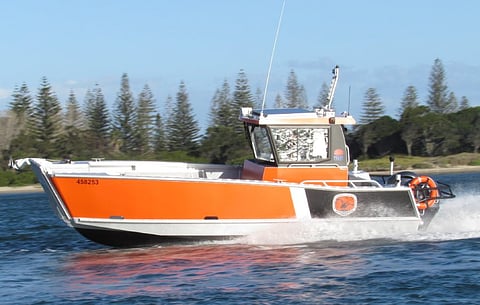

The National Parks and Wildlife Service (NPWS) of New South Wales, Australia, has expanded its fleet of incident response workboats with the addition of a new all-aluminium, utility landing craft designed and built by local company Yamba Welding and Engineering (YWE).
Nawi 1 will be operated mainly around the Hawkesbury River and Sydney Harbour's small islands and bushland. The vessel's primary role will be to transport firefighting teams and their equipment to locations within the NPWS' jurisdiction that are more easily accessible by water.
The landing craft will also be tasked with general support duties, such as the transport of vital equipment that will allow NPWS personnel to undertake conservation works, maintenance, and marine mammal rescues including whale disentanglements. Other roles envisaged are incident management, wildlife surveys, rubbish removal, mooring maintenance, and waterways patrol.
"It was designed as a multi-purpose fast workboat," YWE told Baird Maritime, "with an emphasis on optimised performance and rough water capability when compared to traditional small landing craft. It will also replace an earlier 7.4-metre landing craft in the owner's fleet."
The eight-metre craft is powered by two Yamaha 111kW petrol outboard engines fitted with stainless steel propellers and fed by a 300-litre fuel tank. This configuration delivers speeds of up to 37 knots even when fully loaded and a range of 135 nautical miles when cruising at 23 knots.
"The design brief was to produce a small fast landing craft that can carry a variety of light cargoes, or up to ten persons, and be capable of comfortably operating up to five nautical miles offshore," said YWE. "Due to the substantial area of operation, the loaded vessel speed was important to avoid long transit times."
The cargo deck can accommodate a total load of 650 kilograms and is fitted with recessed lashing points and lightweight closed-cell foam from Ultralon. The coxswain sits on a Relaxn helm seat while two fold-down bench seats are available for the craft's eight passengers.
The electronics suite consists of an ICOM VHF radio, a Lowrance combination GPS/depth sounder, and a Ritchie Voyager compass. These all draw power from a set of Optima batteries augmented by two 95W solar panels.
The craft has a clear cargo deck forward with a wide drop-down bow door and is capable of carrying a variety of payloads, including small all-terrain vehicles, motorised barrows, building materials, and other light cargo. In the personnel transport role, it can accommodate a total of ten persons including crew.
Nawi 1 itself may also be fitted with a specialised water pump, thus providing the craft with its own firefighting capability. There is a permanent sea suction at the transom for connection to a portable fire pump that can be carried on the cargo deck forward. The sea suction is arranged so that it can be raised out of the water when not required, to avoid fouling of the piping when not in use.
YWE said that the primary challenge in the design phase lay in delivering an optimum rough water hull shape and maintaining acceptable cargo-carrying capacity and bow door access whilst staying within the dimensional envelope of an eight-metre-long vessel.
"On the other hand," the company told Baird Maritime, "building the vessel presented no real significant challenges, as it was designed for ease of fabrication. Careful selection of hull parameters and optimising weight distribution were paramount in achieving the design goal."
YWE also remarked that, as a result of the experience gained in producing this craft, construction is underway on a larger 12-metre variant.
| Nawi 1 | |
| SPECIFICATIONS | |
| Type of vessel: | Landing craft |
| Classification: | 2C |
| Flag: | Australia |
| Owner: | NSW National Parks and Wildlife Service, Australia |
| Designer: | Yamba Welding and Engineering, Australia |
| CAD software: | Autocad; Fusion 360 |
| Builder: | Yamba Welding and Engineering, Australia |
| Hull construction material: | Aluminium |
| Superstructure construction material: | Aluminium |
| Deck construction material: | Aluminium |
| Plate cutting: | Bluescope |
| Length overall: | 8.07 metres |
| Beam: | 3.0 metres |
| Draught: | 0.45 metres |
| Depth: | 0.8 metres |
| Displacement: | 4.2 tonnes |
| Capacity: | 650 kilograms |
| Main engines: | 2 x Yamaha 150XCA outboards, each 111 kW |
| Steering system: | SeaStar manual hydraulic |
| Maximum speed: | 37 knots |
| Cruising speed: | 23 knots |
| Range: | 135 nautical miles |
| Batteries: | 4 x Optima D34M 800CCA |
| Electronics supplied by: | Electronic Marine Solutions |
| Radio: | ICOM IC-M423GB VHF |
| Compass: | Ritchie Voyager |
| GPS: | Lowrance Elite 12 Ti2 Combo |
| Alarm system: | High water |
| Windlass: | Lewmar CPX3 Jut Gypsy, 12 V/100 W |
| Other deck equipment: | Rocna superhigh holding power plough anchor |
| Other equipment installed: | Furuno LH5000 loud hailer; bow door; deck lashing points; solar panels |
| Coatings: | Nyalic; vinyl wrap |
| Windows: | Alfab |
| Seating: | Relaxn Bay Series helm seat; 2 x bench seats |
| Interior lighting: | Hella |
| External lighting: | Hella LED |
| Deck surface finish: | Ultralon U-Dek |
| Safety equipment: | AMSA 2C-compliant |
| Firefighting equipment: | Dry powder; fire bucket; water pump; sea suction |
| Type of fuel: | Petrol |
| Fuel capacity: | 300 litres |
| Fuel consumption: | 45 litres per hour at 23 knots |
| Crew: | 2 |
| Passengers: | 8 |
